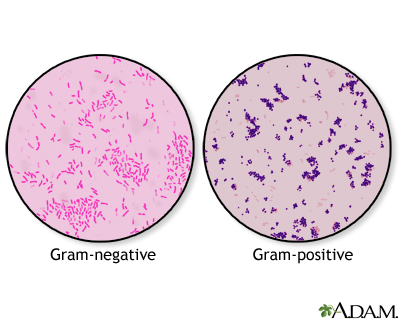Gram stain of skin lesion
Skin lesion Gram stain
A Gram stain of a skin lesion is a lab test that uses special stains to detect and identify bacteria in a sample from the skin. The Gram stain method is one of the most commonly used techniques to quickly diagnose bacterial infections.
Images

I Would Like to Learn About:
How the Test is Performed
Your health care provider will remove a sample of tissue from the skin sore (lesion). This can be done with a simple swab, a needle or syringe, or with a biopsy. If you have a biopsy, your provider will numb the area of skin so you don't feel anything.
The sample is sent to a lab. There, it is applied in a very thin layer to a glass slide. A series of different colored stains are applied to the sample. The stained slide is examined under a microscope to check for bacteria. The color, size, shape, and organization of the cells help identify the germ causing the infection.
How to Prepare for the Test
No preparation is needed for the lab test.
How the Test will Feel
There will be a sting when the anesthetic is given. You should only feel pressure or discomfort similar to a pinprick during the biopsy.
Why the Test is Performed
Your provider may order this test if you have signs of an infected skin sore. The test is done to determine which bacteria caused the infection.
Normal Results
A normal result means no bacteria are present on the Gram stain. Other tests may be done to help diagnose the problem.
What Abnormal Results Mean
An abnormal result means bacteria have been found in the skin lesion. Further tests may be needed to confirm the results. This allows your provider to prescribe the appropriate antibiotic or other treatment.
Risks
Risks of a skin biopsy may include:
- Infection
- Scar
You will bleed slightly during the procedure.
Considerations
A skin or mucosal culture may be done along with this test. Other studies are often done on a skin sample to determine if cancer is present.
Viral skin lesions, such as herpes simplex, are examined by other tests or a viral culture.
References
Dinulos JGH. Bacterial infections. In: Dinulos JGH, ed. Habif's Clinical Dermatology. 7th ed. Philadelphia, PA: Elsevier; 2021:chap 9.
Wojewoda CM, Stempak LM. Medical bacteriology. In: McPherson RA, Pincus MR, eds. Henry's Clinical Diagnosis and Management by Laboratory Methods. 24th ed. Philadelphia, PA: Elsevier; 2022:chap 57.
BACK TO TOPReview Date: 10/11/2024
Reviewed By: Frank D. Brodkey, MD, FCCM, Associate Professor, Section of Pulmonary and Critical Care Medicine, University of Wisconsin School of Medicine and Public Health, Madison, WI. Also reviewed by David C. Dugdale, MD, Medical Director, Brenda Conaway, Editorial Director, and the A.D.A.M. Editorial team.

Health Content Provider
06/01/2025
|
A.D.A.M., Inc. is accredited by URAC, for Health Content Provider (www.urac.org). URAC's accreditation program is an independent audit to verify that A.D.A.M. follows rigorous standards of quality and accountability. A.D.A.M. is among the first to achieve this important distinction for online health information and services. Learn more about A.D.A.M.'s editorial policy, editorial process and privacy policy. A.D.A.M. is also a founding member of Hi-Ethics. This site complied with the HONcode standard for trustworthy health information from 1995 to 2022, after which HON (Health On the Net, a not-for-profit organization that promoted transparent and reliable health information online) was discontinued. |
The information provided herein should not be used during any medical emergency or for the diagnosis or treatment of any medical condition. A licensed medical professional should be consulted for diagnosis and treatment of any and all medical conditions. Links to other sites are provided for information only -- they do not constitute endorsements of those other sites. © 1997- 2025 A.D.A.M., a business unit of Ebix, Inc. Any duplication or distribution of the information contained herein is strictly prohibited.
